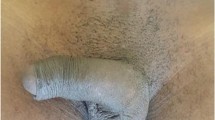Abstract
The commonly held hypothesis that androgens cause testicular descent in the male [9] predicts that excess endogeous androgens in the female fetus might cause descent of the ovary. To re-evaluate this prediction from a clinical perspective, a retrospective review was made of genotypic females with congenital adrenal hyperplasia and severe virilization. Patients with maximal virilization were included, since this is the group with the earlies and highest production of adrenal androgens during fetal development. Records were reviewed of five children in whom the external genitalia were completely or almost completely masculinized, who had been regarded as “males with undescended testes” at birth. The position of the ovaries was determined where possible from operative or pathological reports. In four patients the ovaries had been identified at operation, and were found to be in their normal position. In none were the ovaries in or adjacent to the inguinal canal. In the most recent patient, who presented in 1979, laparotomy was not performed because of the belief that the female internal genitalia were “normal”. In addition, review of the literature revealed two other similar female children with maximal virilization but documented normal ovarian position. The significance of these well-known findings has been ignored in recent studies of testicular descent. Failure of endogenous androgens to affect ovarian position supports the view that initiation of gonadal descent is independent of androgens. Since Müllerian inhibiting substance is the other recognizable hormone in the fetal testis apart from testosterone, it is suggested that it may be responsible for initiating gonadal descent.
Similar content being viewed by others
References
Baumans V, Dijkstra G, Wensing CJG (1983) The role of a nonandrogenic testicular factor in the process of testicular descent in the dog. Int J Androl 6: 542–552
Bierich JR (1963) The adrenogenital syndrome. In: Overzier C (ed) Intersexuality. Academic Press, New York, pp 345–386
Bongiovanni AM, Eberlein WR, Goldman AS, New M (1967) Disorders of adrenal steroid biogenesis. Recent Prog Horm Res 23: 375–449
Dickerman Z, Bauman B, Sandovsky U, Kleinhouse N, Lahmy O, Savir A, Laron Z (1983) Human chorionic gonadotropin (HCG) treatment in cryptorchidism. Andrologia 15: 542
Greene RR, Burrill MW, Ivy AC (1939) Experimental intersexuality. The effect of antenatal adrogens on sexual development of female rats. Am J Anat 65: 415–469
Grunwaldt E, Bates T (1957) Nonadrenal female pseudohermaphroditism after administration of testosterone to mother during pregnancy. Report of a case. Pediatrics 20: 503–505
Hadziselimovic F (1982) Treatment of cryptorchidism with GNRH. Urol Clin North Am 9: 413
Habenicht UF, Newmann F (1983) Hormonal regulation of testicular descent. Adv Anat Embryol Cell Biol 81: 1–51
Hamilton JB (1938) The effect of male hormone upon the descent of the testes. Anat Rec 70: 533–541
Hendren WH, Ginsburg HB (1981) Associated anomalies in undescended testis. In: Fonkalsrud EW, Mengel W (eds) The undescended testis. Year Book Medical Publishers, Chicago, pp 118–134
Hutson JM (1985) A biphasic model for the hormonal control of testicular descent. Lancet II: 419–421
Hutson JM (1986) Testicular feminization: a model for testicular descent in mice and men. J Pediatr Surg 21: 195–198
Hutson JM, Donahoe PK (1986) The hormonal control of testicular descent. Endocr Rev 7: 270–283
Job JC, Canlorbe P, Garagorri JM, Toublanc JE (1982) Hormonal therapy of cryptorchidism with human chorionic gonadotropin (HCG). Urol Clin North Am 9: 405
Jones HW, Scott WW (1971) Hermaphroditism. Genital anomalies and related endocrine disorders, 2nd ed. Williams and Wilkins, Baltimore, p 258
Klidjian AM, Swift PGF, Johnstone JMS (1985) Luteinising hormone releasing hormone for incomplete descent of the testis. Arch Dis Child 60: 568–571
Peres-Palacios G, Jaffe RB (1972) The syndrome of testicular feminization. Pediatr Clin North Am 19: 653–667
Prader A (1954) Der Genitalbefund beim Pseudohermaphroditismus feminis des kongenitalen adrenogenitalen Syndroms. Helv Pediatr Acta 9: 23–248
Rajfer J, Walsh (1977) Hormonal regulation of testicular descent: experimental and clinical observations. J Urol 118: 985–990
Wensing CJG (1973) Testicular descent in some domestic mammals III. Search for the factors that regulate the gubernacular reaction. Proc Kon Ned Akad Wetensch C 76: 196–202
Wilkins L (1965) The diagnosis and treatment of endocrine disorders in childhood and adolescence, 3rd edn. Charles C Thomas, Springfield, p 401
Wilson JD, George FW, Griffin JE (1981) The hormonal control of sexual development. Science 211: 1278–1284
Author information
Authors and Affiliations
Rights and permissions
About this article
Cite this article
Scheffer, I.E., Hutson, J.M., Warne, G.L. et al. Extreme virilization in patients with congenital adrenal hyperplasia fails to induce descent of the ovary. Pediatr Surg Int 3, 165–168 (1988). https://doi.org/10.1007/BF00182774
Accepted:
Issue Date:
DOI: https://doi.org/10.1007/BF00182774




